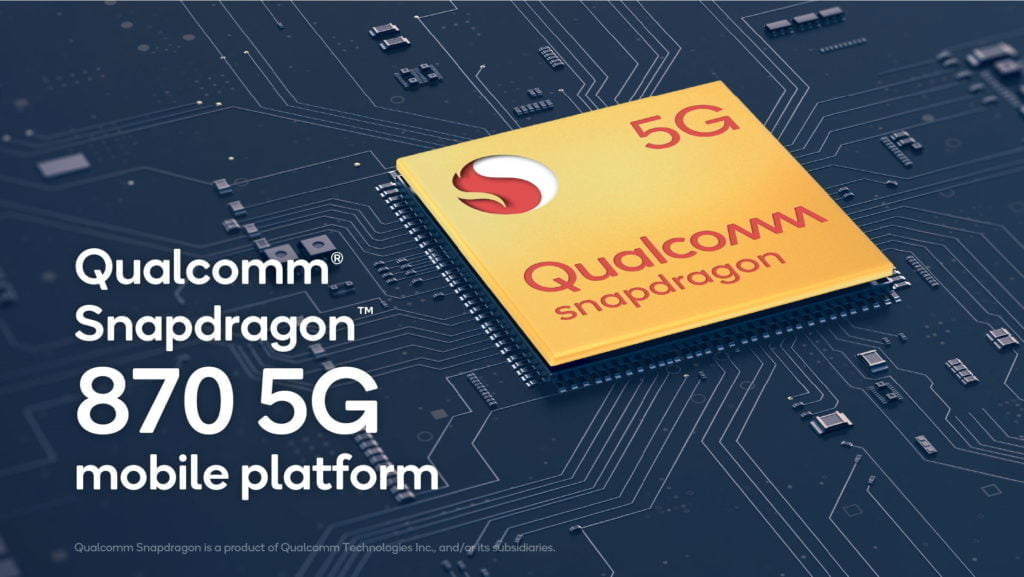Any links to online stores should be assumed to be affiliates. The company or PR agency provides all or most review samples. They have no control over my content, and I provide my honest opinion.
Today, Qualcomm took the wraps of their latest chipset which sits somewhere in a no man’s of being last years tech and flagship spec.
The Qualcomm Snapdragon 870 snapdragon follows a similar trend we have seen from both Qualcomm and MediaTek in the past couple of years. Take an old chipset, tweak it by the smallest of degrees and pass it off as something new.
MediaTek did it with various Helio chipsets, both Qualcomm and MediaTek also appear to have done custom orders for specific brands, namely Xiaomi and Realme, with the likes of the SD732 and Helio G95.
The new Snapdragon appears to be used across OEMs who are predominantly geared towards value-orientated phones. So far, they have Motorola, iQOO, OnePlus, OPPO, and Xiaomi signed up to produce phones with the SD870.
What’s changed?

So, what’s changed? Not much. The spec table below covers most of it, but it is essentially a 0.1GHz bump in frequency on the Cortex A77 core taking it 3.2Ghz representing a 3.23% increase in frequency on a single core.
Timing of this announcement is convenient with MediaTek holding an announcement tomorrow for their flagship chipset, so Qualcomm are perhaps hoping to take the shine off things.
Lower Price Point?
The SD865 increased the price of flagship phones considerably last year, several phones shot well past the £1k point and even affordable brands such as Realme with their X50 Pro were not all that cheap.
The 3.2% frequency difference may not be the important bit here. If the SD870 allows phones to be sold at a new lower price point, it could be a fantastic chipset. The Qualcomm Snapdragon 888 offers impressive performance, but I doubt most people would notice the difference in performance it offers vs last years chipset.
Motorola Moto Edge S with SD870 confirmed to launch in China on 26th of January
Motorola was quick to announce a phone featuring this new chipset with the new Moto Edge S. Last year the Motorola Edge+ launched in the EU and US for €1,199 / $999.99.
It looks like the new phone keeps the same design, and initial leaks suggest the same battery size. So it will be interesting if much else has changed and how the price will relate to last years model.
Qualcomm Snapdragon 870 vs 865 Plus vs 888 Specifications Compared
| SoC | Snapdragon 888 | Snapdragon 870 | Snapdragon 865+ | Snapdragon 865 |
|---|---|---|---|---|
| CPU | 1x ARM Cortex-X1 @ 2.84 GHz | 1x Cortex-A77@ 3.2GHz | 1x Cortex-A77@ 3.1GHz | 1x Cortex-A77@ 2.84GHz |
| 3x ARM Cortex-A78 @ 2.42 GHz | 3x Cortex-A77@ 2.42GHz | 3x Cortex-A77@ 2.42GHz | 3x Cortex-A77@ 2.42GHz | |
| 4x ARM Cortex-A55 @ 1.8 GHz | 4x Cortex-A55 @ 1.80GHz | 4x Cortex-A55 @ 1.80GHz | 4x Cortex-A55 @ 1.80GHz | |
| GPU | Qualcomm Adreno 660 +35% perf | Adreno 650 (same as SD865+?) | Adreno 650 +10% Perf vs SD865 | Adreno 650 @ 587 MHz |
| APU / NPU / AI Proc. / Neural IP | Hexagon 780 26 TOPS AI | Hexagon 698 15 TOPS AI | Hexagon 698 15 TOPS AI | Hexagon 698 15 TOPS AI |
| Memory | 3200MHz LPDDR5 / 51.2GB/s 3MB system level cache | 2133MHz LPDDR4X / 33.4GB/s or 2750MHz LPDDR5 / 44.0GB/s 3MB system level cache | 2133MHz LPDDR4X / 33.4GB/s or 2750MHz LPDDR5 / 44.0GB/s 3MB system level cache | 2133MHz LPDDR4X / 33.4GB/s or 2750MHz LPDDR5 / 44.0GB/s 3MB system level cache |
| ISP/Camera | Triple 14-bit Spectra 580 ISP 1x 200MP or 84MP with ZSL 64+25MP with ZSL 3x 28MP with ZSL 4K video & 64MP burst capture | Dual 14-bit Spectra 480 ISP 1x 200MP or 64MP with ZSL 2x 25MP with ZSL | Dual 14-bit Spectra 480 ISP 1x 200MP or 64MP with ZSL 2x 25MP with ZSL | Dual 14-bit Spectra 480 ISP 1x 200MP or 64MP with ZSL 2x 25MP with ZSL |
| Modem | X60 integrated (5G NR Sub-6 + mmWave) DL = 7500 Mbps UL = 3000 Mbps | X55 external 5G NR Sub-6 + mmWave) DL = 7000 Mbps UL = 3000 Mbps | X55 external 5G NR Sub-6 + mmWave) DL = 7000 Mbps UL = 3000 Mbps | X55 external 5G NR Sub-6 + mmWave) DL = 7000 Mbps UL = 3000 Mbps |
| Process | Samsung 5nm (5LPE) | TSMC 7nm (N7P) | TSMC 7nm (N7P) | TSMC 7nm (N7P) |
I am James, a UK-based tech enthusiast and the Editor and Owner of Mighty Gadget, which I’ve proudly run since 2007. Passionate about all things technology, my expertise spans from computers and networking to mobile, wearables, and smart home devices.
As a fitness fanatic who loves running and cycling, I also have a keen interest in fitness-related technology, and I take every opportunity to cover this niche on my blog. My diverse interests allow me to bring a unique perspective to tech blogging, merging lifestyle, fitness, and the latest tech trends.
In my academic pursuits, I earned a BSc in Information Systems Design from UCLAN, before advancing my learning with a Master’s Degree in Computing. This advanced study also included Cisco CCNA accreditation, further demonstrating my commitment to understanding and staying ahead of the technology curve.
I’m proud to share that Vuelio has consistently ranked Mighty Gadget as one of the top technology blogs in the UK. With my dedication to technology and drive to share my insights, I aim to continue providing my readers with engaging and informative content.







